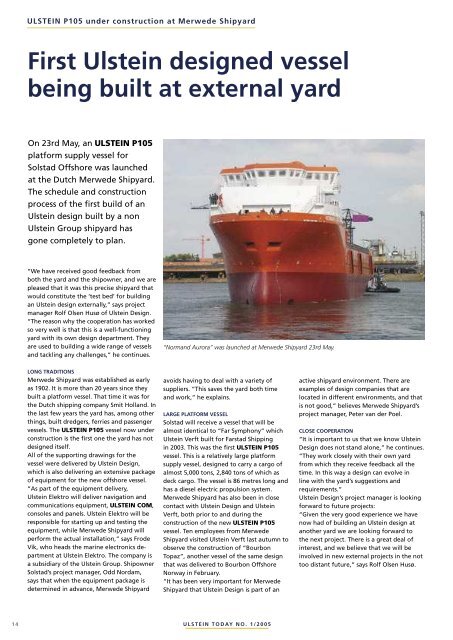Ulstein Today no 1, 2005 - Ulstein Group
Ulstein Today no 1, 2005 - Ulstein Group
Ulstein Today no 1, 2005 - Ulstein Group
Create successful ePaper yourself
Turn your PDF publications into a flip-book with our unique Google optimized e-Paper software.
1 4<br />
ULSTEIN P105 under construction at Merwede Shipyard<br />
First <strong>Ulstein</strong> designed vessel<br />
being built at external yard<br />
On 23rd May, an ULSTEIN P105<br />
platform supply vessel for<br />
Solstad Offshore was launched<br />
at the Dutch Merwede Shipyard.<br />
The schedule and construction<br />
process of the first build of an<br />
<strong>Ulstein</strong> design built by a <strong>no</strong>n<br />
<strong>Ulstein</strong> <strong>Group</strong> shipyard has<br />
gone completely to plan.<br />
“We have received good feedback from<br />
both the yard and the shipowner, and we are<br />
pleased that it was this precise shipyard that<br />
would constitute the ‘test bed’ for building<br />
an <strong>Ulstein</strong> design externally,” says project<br />
manager Rolf Olsen Husø of <strong>Ulstein</strong> Design.<br />
“The reason why the cooperation has worked<br />
so very well is that this is a well-functioning<br />
yard with its own design department. They<br />
are used to building a wide range of vessels<br />
and tackling any challenges,” he continues.<br />
LONG TRADITIONS<br />
Merwede Shipyard was established as early<br />
as 1902. It is more than 20 years since they<br />
built a platform vessel. That time it was for<br />
the Dutch shipping company Smit Holland. In<br />
the last few years the yard has, among other<br />
things, built dredgers, ferries and passenger<br />
vessels. The ULSTEIN P105 vessel <strong>no</strong>w under<br />
construction is the first one the yard has <strong>no</strong>t<br />
designed itself.<br />
All of the supporting drawings for the<br />
vessel were delivered by <strong>Ulstein</strong> Design,<br />
which is also delivering an extensive package<br />
of equipment for the new offshore vessel.<br />
“As part of the equipment delivery,<br />
<strong>Ulstein</strong> Elektro will deliver navigation and<br />
communications equipment, ULSTEIN COM,<br />
consoles and panels. <strong>Ulstein</strong> Elektro will be<br />
responsible for starting up and testing the<br />
equipment, while Merwede Shipyard will<br />
perform the actual installation,” says Frode<br />
Vik, who heads the marine electronics department<br />
at <strong>Ulstein</strong> Elektro. The company is<br />
a subsidiary of the <strong>Ulstein</strong> <strong>Group</strong>. Shipowner<br />
Solstad’s project manager, Odd Nordam,<br />
says that when the equipment package is<br />
determined in advance, Merwede Shipyard<br />
“Normand Aurora” was launched at Merwede Shipyard 23rd May.<br />
avoids having to deal with a variety of<br />
suppliers. “This saves the yard both time<br />
and work,” he explains.<br />
LARGE PLATFORM VESSEL<br />
Solstad will receive a vessel that will be<br />
almost identical to “Far Symphony” which<br />
<strong>Ulstein</strong> Verft built for Farstad Shipping<br />
in 2003. This was the first ULSTEIN P105<br />
vessel. This is a relatively large platform<br />
supply vessel, designed to carry a cargo of<br />
almost 5,000 tons, 2,840 tons of which as<br />
deck cargo. The vessel is 86 metres long and<br />
has a diesel electric propulsion system.<br />
Merwede Shipyard has also been in close<br />
contact with <strong>Ulstein</strong> Design and <strong>Ulstein</strong><br />
Verft, both prior to and during the<br />
construction of the new ULSTEIN P105<br />
vessel. Ten employees from Merwede<br />
Shipyard visited <strong>Ulstein</strong> Verft last autumn to<br />
observe the construction of “Bourbon<br />
Topaz”, a<strong>no</strong>ther vessel of the same design<br />
that was delivered to Bourbon Offshore<br />
Norway in February.<br />
“It has been very important for Merwede<br />
Shipyard that <strong>Ulstein</strong> Design is part of an<br />
U L S T E I N T O D AY N O . 1 / 2 0 0 5<br />
active shipyard environment. There are<br />
examples of design companies that are<br />
located in different environments, and that<br />
is <strong>no</strong>t good,” believes Merwede Shipyard’s<br />
project manager, Peter van der Poel.<br />
CLOSE COOPERATION<br />
“It is important to us that we k<strong>no</strong>w <strong>Ulstein</strong><br />
Design does <strong>no</strong>t stand alone,” he continues.<br />
“They work closely with their own yard<br />
from which they receive feedback all the<br />
time. In this way a design can evolve in<br />
line with the yard’s suggestions and<br />
requirements.”<br />
<strong>Ulstein</strong> Design’s project manager is looking<br />
forward to future projects:<br />
“Given the very good experience we have<br />
<strong>no</strong>w had of building an <strong>Ulstein</strong> design at<br />
a<strong>no</strong>ther yard we are looking forward to<br />
the next project. There is a great deal of<br />
interest, and we believe that we will be<br />
involved in new external projects in the <strong>no</strong>t<br />
too distant future,” says Rolf Olsen Husø.<br />
”Normand Clipper” converted<br />
At work in the pipelaying market<br />
In December last year, <strong>Ulstein</strong> Verft was awarded a contract to convert Solstad’s<br />
cable-layer “Normand Clipper” to a pipelaying construction vessel. At the end of May,<br />
the vessel left <strong>Ulstein</strong> Verft for work in the UK sector.<br />
“Normand Clipper” at <strong>Ulstein</strong> Verft, one week before delivery 27th May.<br />
“The conversion work was on a par with<br />
building a new platform supply vessel and was<br />
completed in five months. The first couple<br />
of months were spent on small jobs such as<br />
removing onboard equipment, cutting away<br />
the hangar and building sections. In February,<br />
the vessel was put into the drydock and work<br />
could start in earnest,” says Lidvar Lillerovde,<br />
the project manager at <strong>Ulstein</strong> Verft.<br />
FITTED FOR CONSTRUCTION WORK<br />
The vessel previously housed a crew of 70,<br />
but more people are needed for construction<br />
projects: “We extended the superstructure<br />
backwards and added extra cabins, as well as<br />
an ROV hangar (hangar for remote controlled<br />
minisubs), an ROV control room, office and<br />
meeting room. There is <strong>no</strong>w room for a crew<br />
of 102. We also installed new lifeboats and<br />
davits,” says Lillerovde.<br />
“A moon pool was installed in the deck for<br />
submerging equipment for subsea operations.<br />
A dynamic positioning system (DP) is required<br />
for such operations so that the vessel can<br />
remain in position in all conditions. The vessel<br />
already had a DP2 system, which has <strong>no</strong>w been<br />
upgraded, and the DP consoles were moved<br />
to the aft bridge. A ma<strong>no</strong>euvring console was<br />
also installed aft for complete control.<br />
A Voyage Data Recorder (VDR), which<br />
receives data from all the onboard<br />
machinery, was installed on the bridge.<br />
THE VESSEL IS BROADER AND STRONGER<br />
<strong>Ulstein</strong> Verft installed a crane column for<br />
a 250 ton, heave-compensated offshore<br />
crane and prepared the port side for the<br />
crane. A new transformer and panel room<br />
that provides the power supply for the<br />
crane was also installed. The 25 ton crane<br />
that was previously installed on the port<br />
side was moved to the starboard side and<br />
upgraded so that it can reach down to 500<br />
metres. The vessel’s beam was increased by<br />
3.6 metres thanks to the installation of side<br />
tanks on each side.<br />
“The increased beam is needed to provide<br />
space for space-demanding deck equipment,<br />
though it also helps to compensate<br />
for the redistribution of weight that occurs<br />
when the new crane swings out over the<br />
side. About 1,300 tons of new steel were<br />
added to the vessel,” reports Lillerovde.<br />
“The working deck has to withstand a full<br />
load of pipes and equipment: we halved<br />
the rib distance and strengthened several<br />
decks. The deck strength was increased<br />
from 3 to 10 tons per square metre.”<br />
U L S T E I N T O D AY N O . 1 / 2 0 0 5<br />
WENT STRAIGHT INTO WORK<br />
After the conversion the vessel sailed for<br />
Newcastle to mobilise for four projects for<br />
Technip Offshore.<br />
“Three of the projects are in the UK sector<br />
and involve laying umbilicals and flexipipes.<br />
The main project involves laying the<br />
main umbilical from Melkøya, off the<br />
coast of Hammerfest in Northern Norway,<br />
to the Snøkvit field,” says Captain Erling<br />
Sandviknes. He explains that umbilicals<br />
are cables that supply subsea installations<br />
with hydraulics, fibre optics and electricity,<br />
among other things, while flexipipes are<br />
used to move gas and oil between seabed<br />
installations.<br />
“We will finish these jobs in August<br />
and install the 250 ton crane. From<br />
1st November we have a 180 day contract<br />
with Clough Ltd. to lay flexipipes off the<br />
coast of India. The contract contains an<br />
option to extend the contract for up to five<br />
years, but we also consider other possible<br />
projects after the fixed period. During the<br />
next three years several interesting pipelaying<br />
and construction market projects<br />
will be awarded, and we will be actively<br />
competing for these,” promises the captain.<br />
1 5




